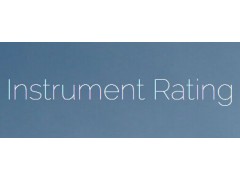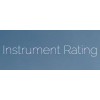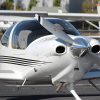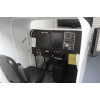Why get the IFR rating?
Earning your IFR rating allows you to take better advantage of your aircraft as a transportation tool. Instead of waiting (on the ground) for the Bay Area fog to clear, you can take off, climb through the fog layer, and proceed to your destination in glorious sunshine. Or if you're returning in the evening, and the fog layer covers the airport, you can simply shoot an instrument approach to a safe landing, rather than havin to land at an alternate (VFR) airport and get a cab back to your original destination. Although the IFR rating does not automatically grant you the ability to fly in any weather conditions, it certainly makes flying more enjoyable and practical.
Is it safe?
While it may seem dangerous to fly an airplane at nearly 200 miles per hour while you can't see anything outside, accident statistics prove that instrument-rated pilots are, in fact, safer pilots. That's why, if you own an aircraft, your insurance rates will decrease significantly after you've earned your IFR rating. The simple truth is, IFR-rated pilots can handle unexpected weather changes that would constitute hazards to a VFR pilot. For example, if you're returning to the Bay Area on a summer evening, and the marine fog layer rolls in and covers your destination airport, you could simply shoot the instrument approach and land safely -- if you're properly rated and proficient at IFR flight. As a VFR-only pilot, you'd have to choose a different airport (without the fog layer obscuring it). So while IFR flying may not be perfectly safe, earning the rating will definitely make you a safer, more proficient pilot.
How difficult is it?
Most veteran pilots say that the IFR rating is probably the most difficult rating (aside from the Airline Transport Pilot certificate) that a pilot can earn. But they'll also tell you that it's the most rewarding. Although IFR training and proficiency demands quite a bit of concentration and effort, there's nothing quite like the feeling of shooting your first "real" instrument approach through a thick cloud layer. And the Bay Area is an ideal location for IFR training, since we have plenty of "soft" IFR (i.e. low clouds and fog) without too much of the "hard" IFR (thunderstorms, ice, and hail) that plagues Florida and the Midwest.
How long will it take?
Before you take your IFR checkride, you must log at least 40 hours of actual or simulated instrument time. Of that 40 hours, 15 hours must be with a certified instrument flight instructor (abbreviated CFII or CFI-IA.) Most people tend to log about 50 hours of actual or simulated instrument time before taking the checkride.
How much flight experience do I need?
In order to take the IFR checkride, you must have at least a private pilot's license. You also have to log at least 50 hours of cross-country pilot-in-command time. (You'll log at least 5 hours of cross-country pilot-in-command time during your private pilot training, and those 5 hours will count towards the 50 hours required for the IFR rating.) In addition, you must log at least 40 hours of actual or simulated instrument time. Of that 40 hours, 15 hours must be with a certified instrument flight instructor (abbreviated CFII or CFI-IA.) Also, during those 40 hours, you'll probably log at least 10 hours of cross-country time, which counts towards the 50 hours mentioned earlier.
We also have an FAA-approved, liggable flight simulators. Of the 40 required flight training hours, 10 hours can be logged in the simulator.
To put it in plain English, most people earn their private licenses after 70 hours of total flight time. After logging, say, 40 hours of VFR cross-country flight, they then begin their IFR training, which lasts about 50 hours. In other words, it's possible to earn your IFR rating with about 150 hours of total flight time.
How much will it cost?
Assuming that you log 50 hours of actual or simulated IFR time, and 30 hours of that is with a CFI-IA, you can plan on spending about $6,000. (You can build the additional 20 hours of simulated IFR time with a qualified safety pilot in the right seat. As long as the safety pilot is at least a VFR-rated private pilot, he or she can look out for traffic while you fly the airplane under a "hood," or view-limiting device that simulates instrument conditions.
Can I get a student loan to finance my flight training?
Sure! We offer discounted student loans through Pilot Finance, Inc., one of the largest lenders in the United States. You can finance part or all of your training costs, and choose from various repayment options. To learn more, click here.
Do I have to attend ground school?
No formal ground school is required. You will, however, be required to thoroughly review textbooks and other prep materials that your instructor will assign you. IFR flying is more of a mental exercise than a physical one, so it's critical that you understand all the procedures, charts, equipment, etc. that you'll be using.
What does the exam for the instrument rating involve?
As with most ratings and certificates, you'll need to take a computerized test. (We provide certified testing services through CATS, a nationwide testing provider.) Your oral exam will last about 90 minutes, and will cover topics listed on the FAA Practical Test Standards (PTS.) Your flight test will take about 2 hours, and will cover the maneuvers and procedures listed in the PTS.
What can I do with an instrument rating?
You can fly in IMC conditions and file IFR flight plans. While you can't actually land the airplane in true "zero-zero" conditions (i.e. zero visibility, with clouds literally touching the ground,) you can land the airplane at many airports if the visibility is at least 1/2 mile and the cloud ceiling is no lower than 200 feet above ground. (In the Bay Area, we almost never see the weather get that bad, except for Monterey and Half Moon Bay airports.)
To put it simply, the IFR rating allows you to use the airplane more as a reliable transportation tool, because you'll be able to fly in weather that keeps VFR pilots grounded. It does not mean that you can fly in any and all weather conditions, because winter storms can be severe enough to ground even the largest airliners. But it's certainly a very useful rating to have.













